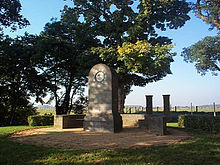Johanna Sebus


Johanna Sebus (born December 28, 1791 in Brienen ; † January 13, 1809 ) from Brienen near Kleve on the Lower Rhine first saved her mother from the floods of the Rhine when a dam broke and then died when she wanted to help other people. Her body was found while the water drained and was buried in cattle in the cemetery. In 1872 her grave was integrated into the building when a new church was built.
Posthumous honors
Johann Wolfgang von Goethe dedicated a ballad to Johanna Sebus in 1809 , in which he described her selfless commitment and her dramatic death. This ballad was set to music by Carl Friedrich Zelter in 1810 at the poet's own request . There is also a version by Franz Schubert (D 728) composed in April 1821 ; the song was first published in 1894/95. In the 1860s, the Düsseldorf history painter Roland Risse took on this material and created an oil painting entitled Johanna Sebus at the break of the Clever Damm in 1809 , which, after the Berlin academic art exhibition, was also shown at the Düsseldorf exhibition of the Kunstverein für die Rheinlande und Westfalen that year Was shown in 1871. A lithograph based on this original was published in 1872 as an illustration in the journal Die Gartenlaube .
In 1811 a memorial was erected in her honor in Wardhausen . At the same time, she was posthumously awarded the White Rose , an honor donated by the French Emperor Napoleon I on the occasion of his accession to the throne on December 2, 1804. This honor goes back to a tradition in northern France and was to be given to a particularly virtuous girl every year in all places under Napoleonic rule, which included Kleve as the main town in the Arrondissement de Clèves . In addition to a rose with golden leaves, these girls, selected by an electoral committee, also received a golden ring and a trousseau . The monument to Johanna Sebus bears an inscription in French on the front. Above the inscription is a white marble rose floating on the water, surrounded by twelve stars. The German translation on the back is from 1953. The house of Johanna's mother Helene Sebus, née van Bentum, was also rebuilt on behalf of the French government, which is documented by a plaque with a Latin inscription in the nearby inn.
In Kleve, the Johanna-Sebus-Gymnasium , which was closed in 2010 and originally a girls' school, remembered the 17-year-old heroine in its name. In Duisburg , too, there was a Johanna-Sebus-Gymnasium until the end of the 1970s , which was also a girls' school. The Catholic primary school in cattle is also named after her.
In Kleve, Xanten and Emmerich streets are named after Johanna Sebus. She is also the namesake of inns and lifeboats in the immediate vicinity of her home village.
literature
- Günter Voldenberg: Johanna Sebus 1809-2009. Self-published, Kleve 2009.
- Gerard Venner: Keverberg's efforts to remember Johanna Sebus. In: Kreis Kleve: Calendar for the Klever Land to the year 2005. Boss, Kleve 2004, ISSN 0174-0520 , p. 92 ff.
- Clemens Reinders : The man who bought Manhattan and other stories from the Lower Rhine. Mercator , Duisburg 2000, ISBN 3-87463-286-5 .
- Karl Gahlings: Johanna Sebus. 2nd revised edition, Boss, Kleve 1984, ISBN 3-922384-14-5 .
- Johannes Derksen : Johanna Sebus. The heroine from the Lower Rhine. A novel. Herder , Freiburg 1954, and St. Benno-Verlag , Leipzig 1956.
- Hermann Arthur Lier: Sebus, Johanna . In: Allgemeine Deutsche Biographie (ADB). Volume 33, Duncker & Humblot, Leipzig 1891, p. 510 f.
Individual evidence
- ↑ Johann Wolfgang von Goethe : Johanna Sebus in the Gutenberg-DE project
- ^ Eusebius Mandyczewski (Ed.): Franz Schubert's works . Series XX: All songs and chants . Breitkopf & Härtel, Leipzig 1894/95, No. 601
- ↑ Risse, Roland. . In: Friedrich von Boetticher : painter works of the nineteenth century. Contribution to art history . Volume II, Dresden 1898, p. 488
Web links
- Goethe's ballad about Johanna Sebus in the Gutenberg-DE project
- How Goethe's ballad about Johanna Sebus came about at Lehrer Online
- Goethe's Johanna Sebus, or: Thanks to the helpers in the floods ( Memento from September 30, 2007 in the Internet Archive ), Berliner Morgenpost , August 18, 2002
- Website of the Johanna-Sebus-Gymnasium , Kleve
- Johanna Sebus in the LVR portal Rheinische Geschichte
| personal data | |
|---|---|
| SURNAME | Sebus, Johanna |
| BRIEF DESCRIPTION | German lifesaver |
| DATE OF BIRTH | December 28, 1791 |
| PLACE OF BIRTH | Brienen (today: Kleve ) |
| DATE OF DEATH | January 13, 1809 |
| Place of death | Brienen (today: Kleve ) |
